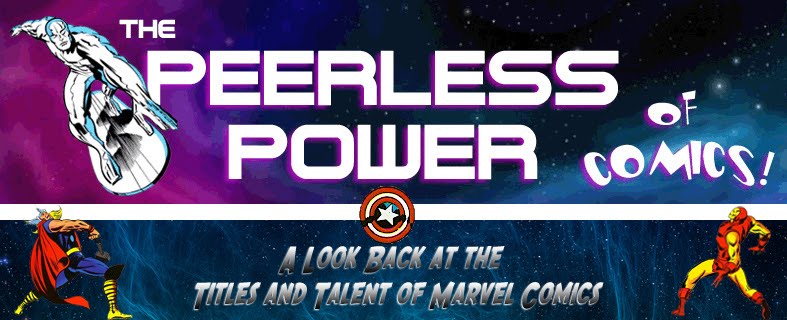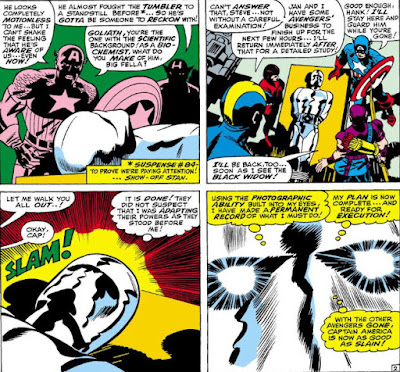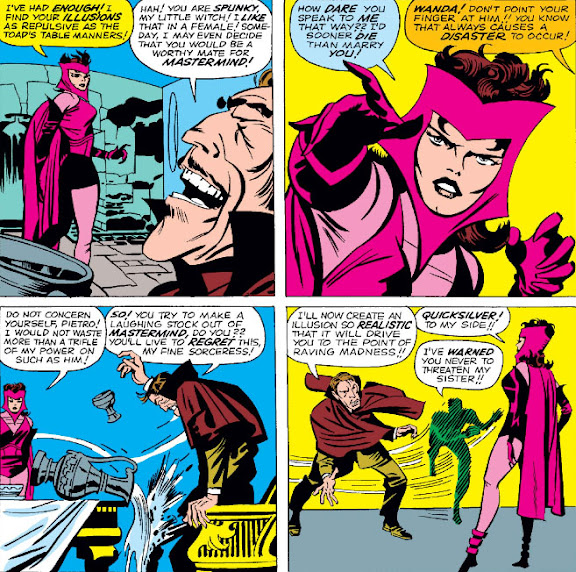The name of
the Masters of Evil has long resonated in Marvel stories--a classic villain group that arguably remains the standard by which other alliances of villains are measured. Many villain groups have come and fallen by the wayside--yet the Masters of Evil, whatever lineup claims the title and whoever claims its leadership, remains
The Masters Of Evil, and its reappearance is never taken lightly. They're one of the few assemblages of villains whose reputation precedes them--and given that they're no strangers to defeat and have often seen their careful and elaborate planning fail to meet with success, the fact that word of their activities is always regarded seriously speaks volumes.
Since we know of the Masters of Evil primarily through the pages of
The Avengers, we can find their premiere appearance in an
Avengers issue from mid-1964, when the original team of Avengers was still building its reputation and its readership, and the time seemed right to give them a villainous super-group that challenged the Avengers' strength in numbers with its own array of deadly opponents.
Pictured side-by-side with an
Avengers Annual cover which reprinted this story, the original and reinterpreted covers by artists Jack Kirby and Sal Buscema (respectively) can't help but evoke a sense of nostalgia from one of the most classic
Avengers tales on the books. The obvious difference between these two covers is of course the suggested presence of the Hulk in this conflict, which was never the case; the Hulk is entirely absent from the original story. The cover takes the liberty of including him only because the annual features another
Avengers story ("The Invasion of the Lava Men!") where the Hulk was a factor in how events played out. (It bears mentioning that the original cover would also mark the Hulk's final appearance in the cover's corner box.) Placing the Hulk in this melee results in a very crowded cover for the annual--and certainly a cause for concern for the Masters of Evil, since it makes the odds 6 to 4 against them. (Also of note is that Rick Jones doesn't make the cut on the revised cover, excluding this member of
the Avengers the Teen Brigade whether by design or necessity. Rick, as we'll see, figures into the story well enough, along with the rest of his "brigaders"--but he's provided with a considerable amount of cover space on his own, for no apparent reason.)
There are 6½ years between these two issues, which gives us an interesting look at how each cover sells the story to the reader. The blurb heralding Zemo and his Masters of Evil is much smaller on the later cover, with the annual choosing to focus our attention on the heroes, instead. As if we couldn't recognize "Captain America! Thor! Iron Man! The Hulk! Giant-Man and the winsome Wasp!" on their own, though there may have been more to the decision. At the time, in the Avengers' monthly title, Thor, Iron Man and Cap were making only
sporadic appearances in the book while writer Roy Thomas strove to build more of a following for the "supporting cast" members such as Quicksilver, the Scarlet Witch, the Vision, and even Goliath--so perhaps the need was felt to reassure the buyer by stressing the fact that this annual featured the Avengers' big guns and was thus well worth their 25¢. (Though the fact that the story is a reprint tends to twist the knife in that respect.)
In addition, the newer cover features none of the "personal touch" wording from Marvel, which in those early days was doing a masterful job of building brand loyalty by communicating with its readers in witty asides and, as is evident here, self-deprecation. There's also considerably more real estate on the annual cover, with the battle taking place on rooftops as opposed to street-level.
For the charter members of the Masters of Evil, it looks like writer Stan Lee has rifled through some old copies of
Journey Into Mystery and
Tales Of Suspense to dig the Melter, the Radioactive Man, and the Black Knight out of mothballs--though Baron Zemo, the group's leader and, we discover, a notorious enemy of Captain America, makes his first appearance here (as opposed to the shadowed figure we briefly saw in a flashback sequence in the story where the Avengers first discovered Cap). Lee's final choices are interesting, considering he had a few other characters available to choose from--for instance,
Mr. Hyde (who would later join another grouping of the Masters),
the Grey Gargoyle,
the Unicorn, and
the Absorbing Man would all have fit into the group as well as did those who made the final cut. (Two others from past tales, the Enchantress and the Executioner, would indeed ally themselves with Zemo soon enough.)
Zemo is a fine choice for the group's leader, since he excels in ruthlessness and planning but also is provided with a connection to Cap that somehow accounts for the mysterious hood he wears, a story within a story that expands this tale into something more than a face-off of costumed characters and which Lee deals into the main plot and handles quite well. But what do the Black Knight, the Melter, and the Radioactive Man bring to the table? The Knight supplies the group with air support and his lance's advanced weaponry; the Melter's value is self-explanatory; while the Radioactive Man's abilities are much like the Melter's but more extensive, without the need for any sort of mechanism. He can also use the light of his power to exert a hypnotic ability (as Zemo can with his "hypno-staff"). It's a given that the Radioactive Man is the group's most lethal member, able to emit his deadly radiation at any level he wishes; in addition, he can withstand a direct hit from Thor's hammer with ease, which certainly makes him an asset going up against the Avengers.
We learn very early in the story of the grudge which Zemo, a former Hitler scientist, holds against Cap, following an incident when the two met during the war and Cap's hurled shield shattered a vat containing Zemo's new project--a super-strong substance known as "Adhesive X" which could not be dissolved. Zemo, who wore a concealing hood over his face to avoid retribution from his victims, was caught in the outpouring of adhesive from the vat, with the substance gluing his hood to his face forever. (Through the miracle of comics, Adhesive X was pretty selective about not coming into contact with the
rest of his clothing, so at least the good Baron wasn't *ahem* stuck wearing a Nazi uniform for life.) When Zemo, living in a jungle in South America, learns of Cap's resurrection, he vows to exact his revenge--though he may find that a two-way street, since we learn that Zemo was responsible for the booby-trapped drone plane which took the life of Cap's young partner, Bucky.
It doesn't take long for the story to establish the connection between Zemo and the others--when, thanks to the release of Adhesive X which effectively paralyzes parts of New York City, the new Masters of Evil attack!























































